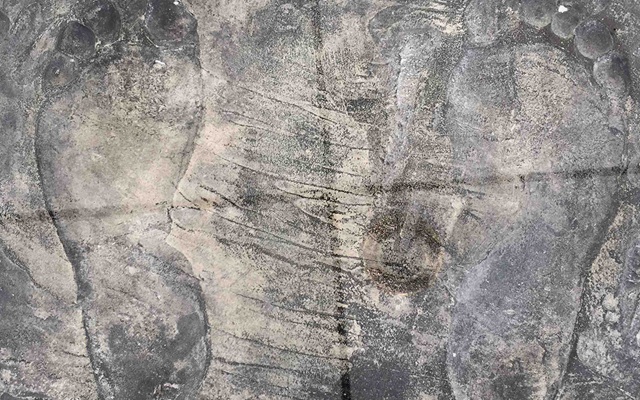This article is a short version of a paper “Re-Establishing the Kingdom: The Anti-Communist Monuments in the Thai Highlands.” The full paper will be published by mid-2017 under the cross-regional research program ‘Ambitious Alignment: New Histories of Southeast Asian Art,’ which was developed by the Power Institute Foundation for Art & Visual Culture, University of Sydney and funded by the Getty Foundation’s Connective Art Histories Initiative.
In the late 1970s, the right-wing movement distributed two Thai maps; one was a map with an image of a communist agent trying to swallow the country from the northeast (Fig. 1), and the other was a map that showed the communist plan to liberate the northeast from the Bangkok hegemony1. These maps conceptualized communism as a threat to the Thai kingdom under the House of Chakri.
On 4 December 1975, two days after King Savang Vattana of the Kingdom of Laos had surrendered his throne to the communist Phathet Laos, King Bhumibol Adulyadej (King Rama IX, r. 1946-2016) gave a royal speech to an audience of well-wishers on the occasion of his 48th birthday. The speech stated that he heard that some people had predicted that “by the end of this year, Thailand will not appear on the world map anymore” and “I have seen a map on which Thailand was labelled as “Dieland.”2 At that time, Laos, Cambodia, and Vietnam had fallen to communist forces. This particular speech and the aforementioned maps thus expose a security panic within the nation’s border regions. It was a fear that the sovereign state would be destroyed by communism. The threat to the nation and the threat to the throne were one and the same thing. The monarchy decided to fight and called for national unity.3 Following the December speech, the King granted a New Year wish for the Thai people, with the highly nationalist poem “We Fight” (Roa Su).
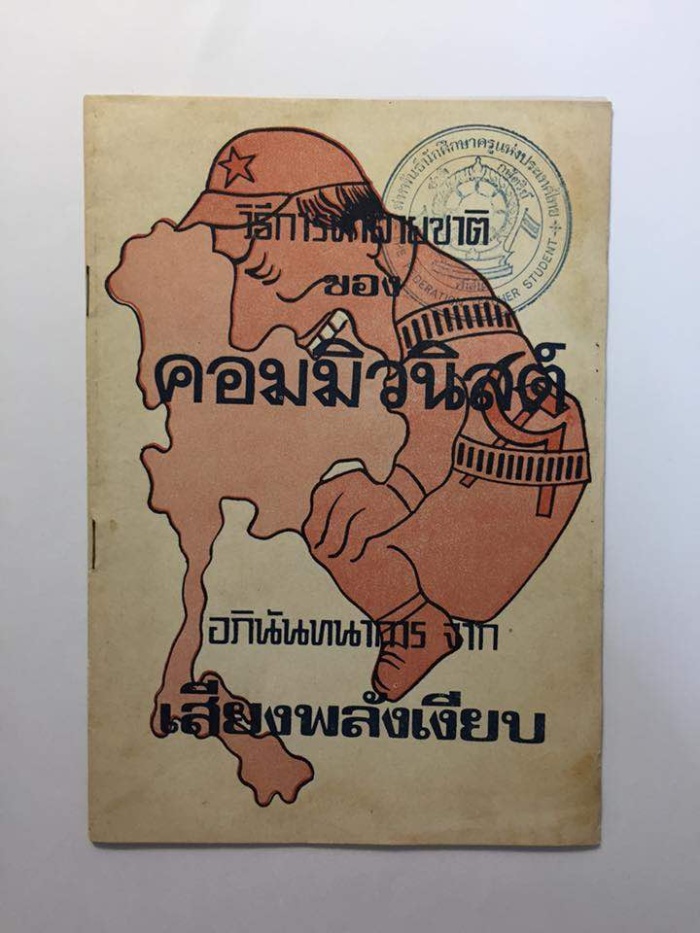
Il. 1 Książeczka The Way Communism Destroys the Country [W jaki sposób komunizm niszczy kraj], 1976. Fot.: Thanavi Chotpradit.
During the Cold War era, Thailand played a crucial role in blocking communist gains in the region. The communist insurgency in Thailand was a guerrilla war lasting from the 1960s to the 1980s. It involved the Communist Party of Thailand (CPT), the Thai state, and the United States. The Thai borderland became the strategic arena for the state’s counter-insurgency. In the Cold War context, national territory, which defines the Thai “geo-body”4 as a “kingdom” was supremely important. This article will discuss the proliferation of war monuments in the border provinces of the highlands (Chiang Rai, Phayao, and Nan).5 The central argument of this article is an act of marking and reclaiming the highlands from communist infiltration through the erection of anti-communist monuments.
Defining the Nation’s Space: The State Monuments of the Highlands
The maps mentioned above might have pointed remarkably to the northeast of the country but the north, particularly the highlands, was also under communist threat. Along the border with Laos, the highlands are the mountainous region with deep forests and inaccessible valleys. It is a home of ethnic minorities or chao khao, which literary means “mountain people” as well as “the Other.” When the CPT opened new fronts in Chiang Rai and Nan in the early 1960s, many chao khao became communist sympathizers. Consequently, the CPT declared Nan as a liberated zone in the 1970s.
Several violent armed struggles in the highlands led to a glorification of the fallen soldiers, policemen, and civilian volunteers in the form of a war monument. The Thai state erected several sacrificial monuments dedicated to the fallen heroes such as the Thung Chang Sacrificial Monument (Anusaowari Wira Kam Phonlaruean, Tamruat, Thahan) in the Thung Chang district, Nan (1976) (Fig. 2), the Memorial to the Brave Soldiers of the Ban Huai Kon Battalion (Anuson Thahan Kla Than Ban Huai Kon) (1999) (Fig. 3), the Sacrificial Monument (Anusaowari Phu Sia Sala) in the Mengrai Maharat Camp, Chiang Rai (1978) (Fig. 4) and the Memorial to the Sacrificial Civilian, Policemen and Soldiers 2324 (Anuson Phu Sia Sala Phonlaruean, Tamruat, Thahan 2324) in Chiang Kham district, Phayao (1990) (Fig. 5).6 These fallen heroes appeared as national patriots or wirachon who had sacrificed their lives for the country.
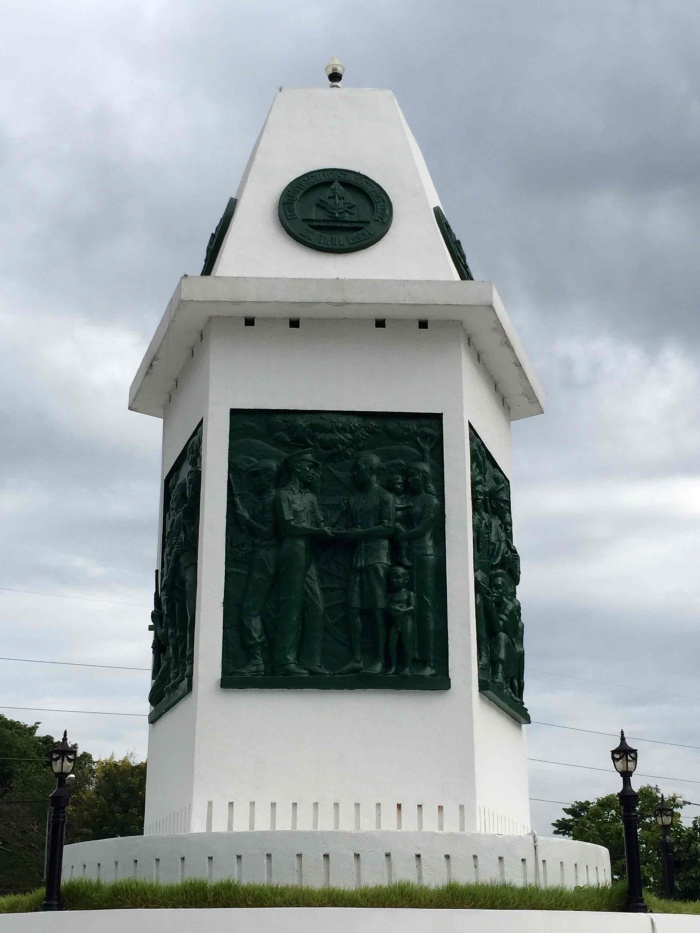
Il. 5. Somkiat Homanek, Pomnik Ofiarny Cywilów, Policjantów i Żołnierzy 2324, 1990. prowincja Chiang Kham, Phayao. Fot.: Thanavi Chotpradit.
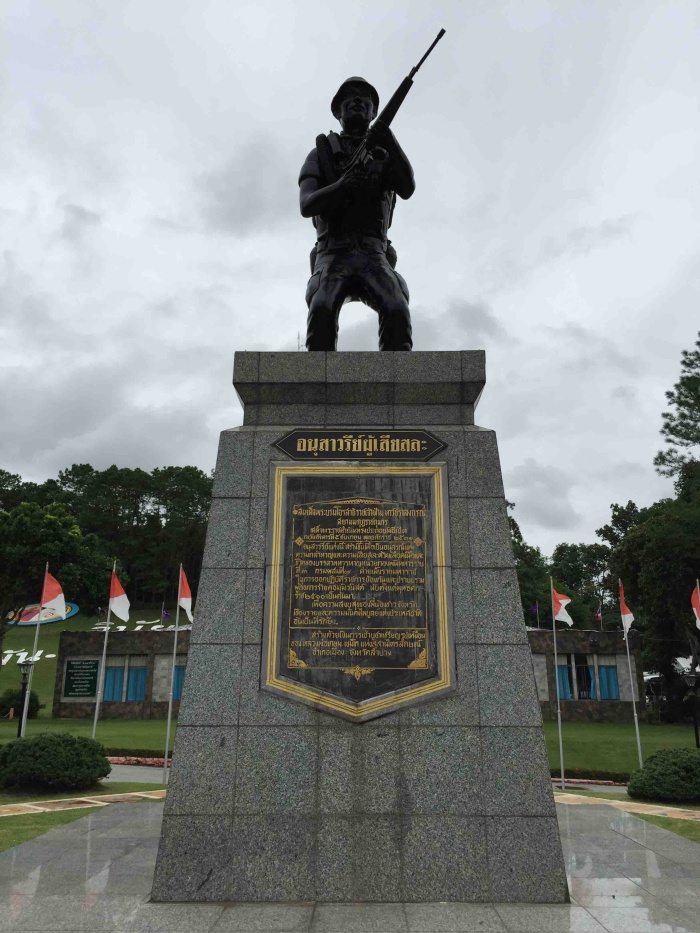
Il. 4. Pomnik Ofiarny, 1978. Obóz Mengrai Maharat, Chiang Rai. Fot.: Thanavi Chotpradit.
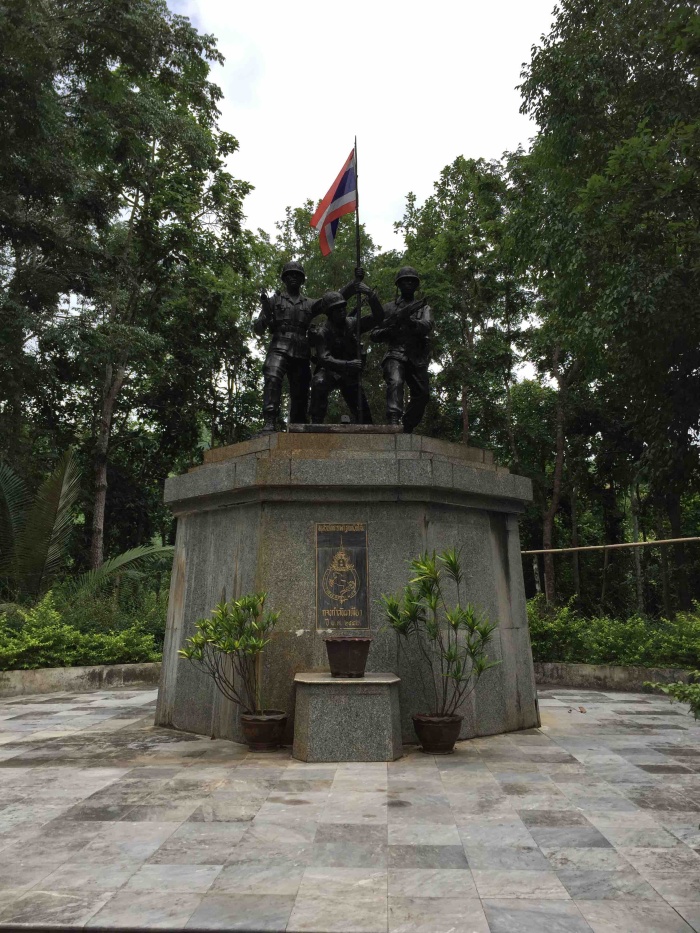
Il. 3. Pomnik Dzielnych Żołnierzy Batalionu Ban Huai Kon, 1995. Wieś Ban Huai Kon, prowincja Thung Chang, Nan. Fot.: Thanavi Chotpradit.
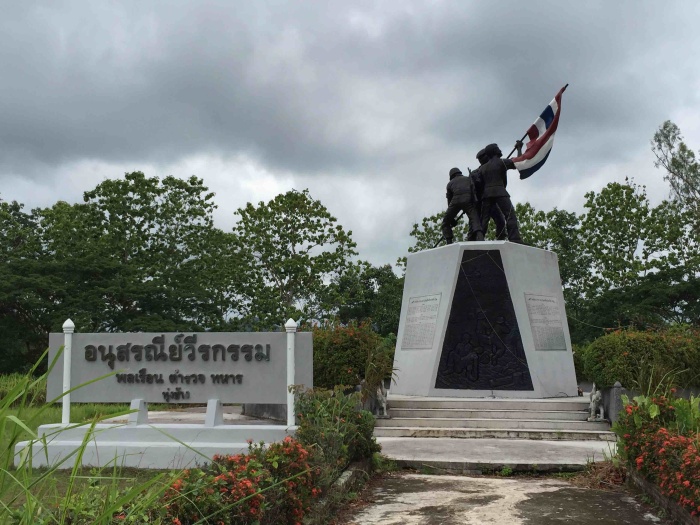
Il. 2. Pomnik Ofiarny Thung Chang, 1976. Prowincja Thung Chang, Nan. Fot.: Thanavi Chotpradit.
The first monument in the highlands is the Thung Chang Sacrificial Monument in Thung Chang district, Nan (Fig. 2). It was erected in 1976, in commemoration of the battle of the Ban Huai Kon Battalion in 1975. Ban Huai Kon was a small chao khao village. Located only five km away from the Lao border, the village was on the communist’s route to their headquarters in Muang Ngeun, Xaignabouli, Laos. The communist guerrillas attacked the Thai army’s battalion on a hill near the village on 9 April 1975, leaving seventeen soldiers dead in the battle (plus one who died at the Nan Hospital). The invaders raised the red flag in the village and the villagers escaped to Muang Ngeun. To commemorate this incident, the Thung Chang Sacrificial Monument was unveiled on 10 February 1976 and the Ban Huai Kon Battalion became a site museum in 1999 (Fig. 3). The Memorial to the Brave Soldiers of the Ban Huai Kon Battalion consists of an exhibition hall, reconstructions of the trenches and a monument to the seventeen fallen soldiers.
The Thung Chang Sacrificial Monument and the Monument to the Fallen Soldiers at the Memorial to the Brave Soldiers of the Ban Huai Kon Battalion have the same appearance but are slightly different in the details. The former presents the government troops as a group of life-sized bronze sculptures, consisting of a soldier, policeman, and civilian on a high hexagonal pedestal. In their hands is the sculptural Thai national flag. Three panels on the pedestal show realistic bas-reliefs that depict the troop’s heroic deeds while another three panels are engraved with the names and ranks of the deceased. The latter contains a group of three soldiers standing on a high hexagonal pedestal but includes a real Thai national flag, rather than its sculptural representation. There might not be any panel with names and ranks of the seventeen soldiers here but marking the spots where they were killed highlights their sacrifice (Fig. 6). These marks on the reconstructed trenches both enhance the tragedy of war and the authenticity of museum.

Il. 9. Pomnik Pho Khun Jeung Thammikarata, 1990. Obóz Khun Jeung Thammikarat, Phayao. Fot.: Thanavi Chotpradit.

Il. 7. Wizerunki apsara na płycie z inskrypcją na Pomniku Ofiarnym Cywilów, Policjantów i Żołnierzy 2324. Fot.: Thanavi Chotpradit.
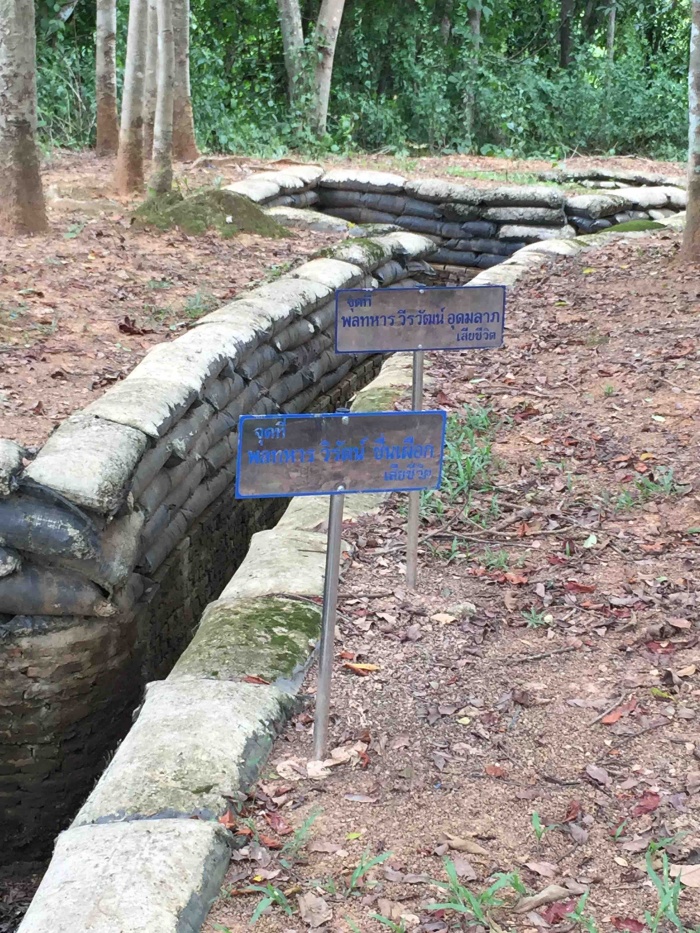
Il. 6. Rekonstrukcja okopu i oznaczenia miejsc śmierci żołnierzy na Pomniku Dzielnych Żołnierzy Batalionu Ban Huai Kon. Fot.: Thanavi Chotpradit.
The transformation of the actual combat zone into a site museum demonstrates the state’s attempt to reshape the memory of the war. The leaflet provided by the 32nd Ranger Regiment, an organization responsible for the site, omits the fact that Thailand lost the village of Ban Huai Kon to the communist guerrillas.7 It does not mention that the guerrillas raised the red flag over the village. It only states that Thai forces secured the battalion and found a red flag that the guerrillas had prepared to raise in the battalion. This selected information reconstructs a whole new memory of the event’s aftermath by erasing the supposed disgrace of the communist’s triumph on Thai soil. The interaction between the marks on the trenches where the seventeen soldiers were killed and the monument dedicated to them creates a post-1975 narrative in which the Thai state could secure its sovereignty across the entire borderland.
Chiang Rai, which includes present-day Phayao, was another combat zone in the counter-insurgency. The Sacrificial Monument in the Mengrai Maharat Camp, Chiang Rai (1978) (Fig. 3) commemorates the soldiers of the 3rd Infantry Battalion of the 7th Infantry Regiment from the Mengrai Maharat Camp, who fought against communism from 1967 onwards. It presents the lone figure of a soldier on a high pedestal with an engraving of the names and ranks of all the fallen soldiers. The soldier is in a “readied” position as he carries his gun and looks towards an invisible enemy, his facial expression showing courage and determination as he reaches towards his opponent. Like the Monument to the Fallen Soldiers at the Memorial to the Brave Soldiers of the Ban Huai Kon Battalion, the Sacrificial Monument in the Mengrai Maharat Camp underlines the military’s leading counter-insurgency role.
The monuments in Nan and Chiang Rai highlight the nobility of common warriors, soldiers, policemen and civilians, and the unity of the country’s citizenry in fighting their enemies. The figures served as a type of visual rhetoric that clearly expresses a fighting spirit. They arouse in the onlooker patriotic sentiments, as they provide instructions for good citizenship and teach the living how to die as national patriots.8 The presentation of wirachon, or fallen heroes in a monumental form is intended to inspire the living with enthusiasm, love and loyalty for the nation.
However, the monument dedicated to the fallen in the Memorial to the Sacrificial Civilians, Policemen and Soldiers 2324 in Chiang Kham district, Phayao (Fig. 5) appears differently; the designer of the monument, Captain Somkiat Homanek, took inspiration from fortifications.9 The monument has a pentagonal structure on a round pedestal with a symbol of the Civilian-Police-Military Command-43 (CPM-43) on its top. Four of the panels contain narrative bas-reliefs that describe the roles of the CPM-43 and one panel bears an inscription plaque interposed by two images of apsara (angels). The huge panel behind the monument that inscribes the names and ranks of the fallen also displays images of another two apsara in the act of praying as they accompany the dead to heaven (Fig. 7). By taking the deceased to heaven, the images of apsara offer consolation for individual grief by serving as a form of reparation for the loss of life.
The unveiling ceremonies of these sacrificial monuments indicate a close relationship between the Thai army and the monarchy. While King Bhumibol and Queen Sirikit attended the unveiling ceremony of the Thung Chang Sacrificial Monument in 1975, Crown Prince Maha Vajiralongkorn,10 King Bhumibol’s official heir, served as the President of the unveiling ceremony of the Sacrificial Monument in the Mengrai Maharat Camp in 1978. The opening of the Memorial to the Brave Soldiers of the Ban Huai Kon Battalion as a site museum in 1999 is also a result of Princess Maha Chakri Sirindhorn’s having visited the site in 1995. These royal acts point remarkably to the bond between the monarch and the soldiers. Furthermore, the military-monarchy was encapsulated in the granting of two plaster casts of King Bhumibol’s footprints at the Doi Phaya Pitak Battalion on the top of the mountain Doi Yao in Thoeng district, Chiang Rai in February 1982 (Fig. 8).11 The Royal visit to the Doi Phaya Pitak Battalion included King Bhumibol, Queen Sirikit, Princess Maha Chakri Sirindhorn and Princess Somsawali, a niece of Queen Sirikit and the then-wife of the Crown Prince Maha Vajiralongkorn. It was only one month before the end of the counter-insurgency in the highlands.
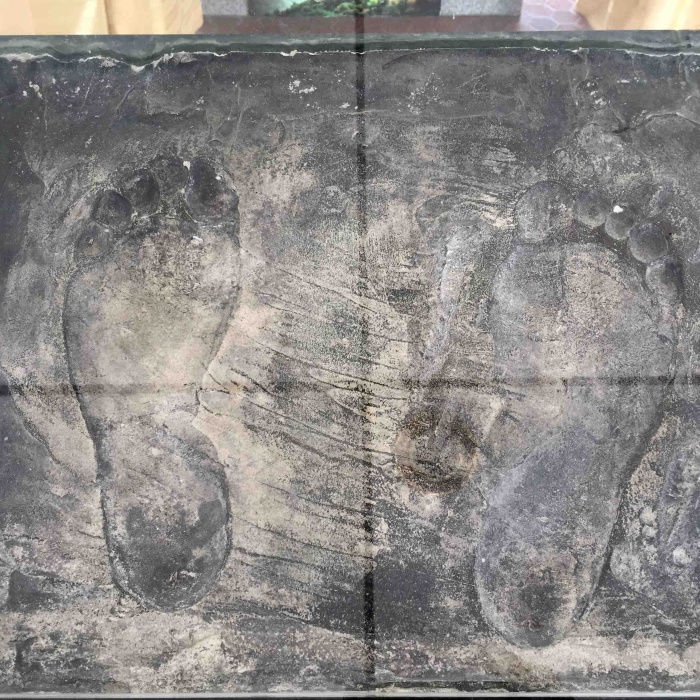
Il. 8. Królewski Odcisk Stopy Króla Bhumibola, 1982. Pawilon Odcisku Stopy w obozie Mengrai Maharat Camp, Chiang Rai. Fot.: Thanavi Chotpradit.
One set of the Royal Footprint was installed in the Footprint Pavilion in the Mengrai Maharat Camp near the Sacrificial Monument. This location initiates an interaction between the King’s non-anthropomorphic monument and the Sacrificial Monument. It marks the intimate relationship between the King and the military and affirms the commoners’ status as the King’s subjects by reinforcing that they died protecting the kingdom. Going beyond this monument in the Mengrai Maharat Camp to other sacrificial monuments in the highland region, the King’s footprint conceptualizes the act of the individual commoner as a collective act of national devotion. It emphasizes the fallen commoners as patriotic martyrs and reinforces the discourse of the undividable kingdom. Loyalty to the nation and the throne is materialized in these commemorative structures in other words, the physical manifestation of loyalty comes in the form of the war monument.
The placement of the Royal Footprint has a symbolic role in spatially defining the boundaries of the Thai kingdom. It marked the creation of an emblematic landscape as well as ownership of the highlands as part of the Thai state under the Chakri monarch. By serving as a trace of the sovereign’s body in the highlands, a place where the King and his family travelled intensively during the counter-insurgency, the Royal Footprint reveals the most fundamental political concerns of the day as border security and the attempt to define the northern borderland as royal territory. It should also be noted that King Bhumibol is a supreme symbol of anti-communism. This is largely a part of USIS anti-communist policy in Thailand. During the USIS area visits in the countryside, pictures of King Bhumibol and Queen Sirikit were widely distributed with maps of Thailand in the countryside.12 The two images both emphasize the importance of national boundaries and conceptualized Thailand as a monarchical state. The unity of the land and the King was also solidified in the name of the King himself; “Bhumibol,” which derives from the Sanskrit words “Bhumi” (land) and “Bala” (strength) literally means “the Strength of the Land.”
The propagation of Bangkok’s hegemony is also manifested in the erection of statues of local historical overlords—pho khun and/or phaya in the northern region. These historical overlords in the north of present-day Thailand are perceived as kings of former “Thai” kingdoms. There are numerous overlord statues throughout the highlands and beyond including those in Phayao, Chiang Rai, Tak, and Petchabun. The Thai army erected these statues in military camps, or named the military camps after these “kings,” for example, the statue of Pho Khun Jeung Thammikarat in Khun Jeung Thammikarat Camp in Phayao (1990) (Fig. 9). Pho Khun Jeung Thammikarat was the overlord who ruled Phayao (then Phu Pham Yao Kingdom) in the 11th century. According to the information panel behind the statue, he was a great warrior and ruler who expanded his kingdom into Yunnan. The statue of Pho Khun Jeung Thammikarat depicts him as a warrior king in traditional costume with one hand holding a sword. It is evident that his value derived from the story of his rule over and expansion of his territory through war. His statue thus does not simply evoke the historical past or mythology of past wars, but rather relates to the present situation concerning questions over ownership of the land.
As the Thai historian Nidhi Eosiwong has remarked, the monument was a powerful state device in constructing a plot of history.13 Pho Khun Jeung Thammikarat provides a reminder of past wars and weaves them into the fabric of the Cold War struggle. His image is integrated into the national narrative of counter-insurgency and becomes the guardian spirit of the city of Phayao.
These historical overlords appeared as the guardian spirits of cities, which are part of modern Thailand. By representing these overlords as the protectors of the realm, their statues assert that these border-regions are part of the Thai geo-body and legitimize King Bhumibol’s right to rule. Thus, they are objects that hold immense power in creating imaginary continuity with the past and a sense of solidarity for the “Thai clan” under the royal ruler. As such, the statue of Pho Khun Jeung Thammikarat indicates the deployment of narratives of the past and of historical figures to construct an imagined historical territory of the present Thai nation-state.
The incorporation of Pho Khun Jeung Thammikarat into the national narrative suggests a centralization that extends across time and space. This overlord statue establishes a fictive kinship between the local ruler and King Bhumibol and therefore legitimizes his right to rule the northern lands. As such, the statue performatively works on both time and space as it contributes to shaping the contemporary national landscape. It demonstrates the politicization of memory by the present and the formation of the imagined historical evolution of the Thai state through fictive kinship.
In conclusion, the sacrificial monuments, the Royal Footprint and the statue of Pho Khun Jeung Thammikarat play crucial role in legitimizing authority and unifying the citizens of the nation state during a time when the country was under a communist threat. The act of erecting monuments is thus an act of demarcation; it demonstrates the state’s attempt to re-conceptualize the Thai geo-body, to fix its borders and to reabsorb liberated zones back into the kingdom. As such, landscape, as a mode of political discourse, has the ability to reify and reaffirm political vision.14 These monuments emphasize that it has always been the duty of all Thais to protect the kingdom from foreign enemies, which was, in this case, communism. Since the marking of national space through war monuments engages with reclaiming lost territories, it is also involved in the centralization and Thai-ization of peripheral peoples and communist sympathizers in the highlands. The reform of the mountainous lands thus includes the subsuming of chao khao—the Other—to a new national identity as chao thai phu khao—Mountain Thai or Thai mountain people.15 As such, the landscape of the Thai highlands where war monuments are scattered is a site through which the Thai nation-state as a kingdom under Bhumibol’s rule is reaffirmed. The Cold War monuments transform this sensitive border zone into the fixed and indestructible boundary of the Thai kingdom.
BIO
Thanavi Chotpradit is a lecturer in Modern and Contemporary Thai Art History at the Department of Art History, Faculty of Archaeology at Silpakorn University in Thailand and a member of the editorial collectives of SOUTHEAST OF NOW: Directions in Contemporary and Modern Art, a peer-reviewed journal due to launch in 2017. She completed her Ph.D. in Art History at Birkbeck, University of London under a Royal Thai Government Scholarship on the Project of Human Resource Development in the Humanities and Social Sciences. In 2015-2016, Thanavi participates in the cross-regional research program “Ambitious Alignment: New Histories of Southeast Asian Art,” developed by the Power Institute Foundation for Art & Visual Culture, University of Sydney and funded by the Getty Foundation’s Connective Art Histories Initiative. She has also contributed essays to the Thai journals, Aan Journal and Fa Diew Kan. Her areas of interest include Modern and Thai contemporary art in relation to memory studies, war commemoration, and Thai politics.
References
Thai literatures
Eiji Murashima, Kamneot Phak Communist Siam [The Origin of the Communist Party of Siam], Kosit Thipthiempong (transl.), Matichon, Bangkok, 2012.
Nidhi Eosiwong, ‘Songkhram Anusaowari kap Rat Thai’ [Wars on Monuments and the Thai State], Silpawattanatum, 11: 3, January 1990, pp. 266-284.
Somsak Jeamteerasakul, Prawatsat thi Phoeng Sang [History that Has Just Been Constructed], 6 Tularamleok, Bangkok, 2001.
The 32nd Ranger Regiment, The Memorial to the Brave Soldiers of the Ban Huai Kon Battalion, leaflet, no date.
The Fine Art Department, Anusaowari nai prathet Thai Vol. 1 [Monuments in Thailand Vol. 1], Literature and History Division, The Fine Art Department, Bangkok, 1996.
English literatures
Benedict Anderson, Imagined Communities: Reflections on the Origin and Spread of Nationalism, Verso, London, 1983.
Benedict Anderson, ‘Withdrawal Symptoms: Social and Cultural Aspects of the October 6 Coup’, Bulletin of Concerned Asian Scholars, 9:3, July–September 1997, pp. 13–30.
Bhumibol, King, Royal Speech Given to the Audience of Well-Wishers on the Occasion of the Royal Birthday Anniversary at the Dusidalai Hall, Chitralada Villa, Dusit Palace on Wednesday, December 4, 1974, Thursday, December 4, 1975, Saturday, December 4, 1976, Sunday, December 4, 1977, Monday, December 4, 1978, Amarin Printing and Publishing, Bangkok, 1998.
George L. Mosse, Fallen Soldiers: Reshaping the Memory of the World Wars, Oxford University Press, New York; Oxford, 1990.
Hjorleifur Jonsson, Mien Relations: Mountain People and State Control in Thailand, Cornell University Press, Ithaca and London, 2005.
Ian G. Baird, and Philippe Le Billon, ‘Landscape of Political Memories: War Legacies and Land Negotiation in Laos’, Political Geography, 31, 2012, pp. 290-300.
Jay Winter, Sites of Memory/Sites of Mourning: The Great War in European Cultural History, Cambridge University Press, Cambridge, 1995.
Katherine A. Bowie, Rituals of National Loyalty: An Anthropology of the State and the Village Scout Movement in Thailand, Columbia University Press, New York, 1997.
Kullada Kesboonchoo Mead, ‘The Cold War and Democratization in Thailand’, in Albert Lau (ed.) Southeast Asia and the Cold War, Routledge, Milton Park, Abingdon, Oxon; New York, 2012, pp. 215-240.
Michael Rowlands ‘Remembering to Forget: Sublimation as Sacrifice in War Memorials’, in Adrian Forty and Susanne Küchler (eds), The Art of Forgetting, Berg, Oxford and New York, 1999, pp. 129-145.
Pinkaew Laungaramsri, ‘Constructing Marginality: The ‘Hill Tribe’ Karen and Their Shifting Locations within Thai State and Public Perspectives’, in Claudio O. Delang (ed.) Living at the Edge of Thai Society: The Karen in the Highlands of Northern Thailand, RoutledgeCurzon, London and New York, 2003, pp. 21-42.
T. G. Ashplant, Graham Dawson and Michael Roper (eds), The Politics of War Memory and Commemoration, Routledge, London and New York, 2000.
Thongchai Winichakul, Siam Mapped: A History of the Geo-Body of a Nation, University of Hawai’i Press, Honolulu, 1997.
Mobile Information Team I, Trip 7: A Report by the United States Information Service, Bangkok, December 12 to 22, United States Information Service, Bangkok, 1962, cited in Phimmasone Michael Rattanasengchanh, Thailand’s Second Triumvirate: Sarit Thanarat and the Military, King Bhumibol Adulyadej and the Monarchy and the United States. 1957-1963, Master Thesis, University of Washington, 2012, p. 50.
W. J. T. Mitchell (ed.), Landscape and Power, The University of Chicago Press, Chicago and London, 1994.
Newspapers
Deli News, 12 April 1975, p. 3.
Siam Rath, 15 April 1975, no pagination.
*Cover photo: The Royal Footprint of King Bhumibol, 1982. The Footprint Pavilion in Mengrai Maharat Camp, Chiang Rai. Photograph: Thanavi Chotpradit.
[1] Somsak Jeamteerasakul, Prawatsat thi Phoeng Sang [History that Has Just Been Constructed], 6 Tularamleok, Bangkok, 2001, p. 132-133.
[2] King Bhumibol, Royal Speech Given to the Audience of Well-wishers on the Occasion of the Royal Birthday Anniversary at the Dusidalai Hall, Chitralada Villa, Dusit Palace on Wednesday, December 4, 1974, Thursday, December 4, 1975, Saturday, December 4, 1976, Sunday, December 4, 1977, Monday, December 4, 1978, Amarin Printing and Publishing, Bangkok, 1998, p. 24.
[3] On the monarchy’s role as a symbol of anti-communism in relation to the American intervention in Thailand during the Cold War, see for example, Benedict Anderson, ‘Withdrawal Symptoms: Social and Cultural Aspects of the October 6 Coup’, Bulletin of Concerned Asian Scholars, 9:3, July–September 1997, pp. 13–30; Katherine A. Bowie, Rituals of National Loyalty: An Anthropology of the State and the Village Scout Movement in Thailand, Columbia University Press, New York, 1997 and Kullada Kesboonchoo Mead, ‘The Cold War and Democratization in Thailand’ in Albert Lau (ed.) Southeast Asia and the Cold War, Routledge, Milton Park, Abingdon, Oxon; New York, NY, 2012, pp. 215-240.
[4] According to Thai historian Thongchai Winichakul, maps are visual representation of the nation space and territory. It defines a “geo-body” of the nation. See Thongchai Winichakul, Siam Mapped: A History of the Geo-Body of a Nation, University of Hawai’i Press, Honolulu, 1997.
[5] Phayao was part of Chiang Rai until 1977.
[6] The construction of the Memorial to the Sacrificial Civilian, Policemen and Soldiers 2324 was first considered in 1980. The Memorial to the Brave Soldiers of the Ban Huai Kon Battalion commemorates the fighting in 1975.
[7] There were at least two newspapers that reported on the communists’ seizure of the village and their raising of the red flag. See Deli News, 12 April 1975, 3 and Siam Rath, 15 April 1975, no pagination.
[8] See Benedict Anderson, Imagined Communities: Reflections on the Origin and Spread of Nationalism, London, Verso, 1983 and Michael Rowlands, ‘Remembering to Forget: Sublimation as Sacrifice in War Memorials,’ in Adrian Forty and Susanne Küchler (eds), The Art of Forgetting, Berg, Oxford and New York, 1999, p. 129-145.
[9] The Fine Art Department, Anusaowari nai prathet Thai Vol. 1 [Monuments in Thailand Vol. 1], 165.
[10] King Bhumibol passed away on 13 October 2016 but, by the time of this writing, the Crown Prince Maha Vajiralongkorn has not been officially crowned. There has been speculation that the Crown Prince will take the throne on 1 December 2016 but the Bureau of the Royal Household (BRH) has not officially announced.
[11] The Royal Footprint connects the King with the Buddha and the notion of Buddhist Dharma King since the footprint of the Buddha (Buddhapada) was an early representation of him in the aniconic stage of Buddhist art.
[12] Mobile Information Team I, Trip 7: A Report by the United States Information Service, Bangkok, December 12 to 22, United States Information Service, Bangkok, 1962, cited in Phimmasone Michael Rattanasengchanh, Thailand’s Second Triumvirate: Sarit Thanarat and the Military, King Bhumibol Adulyadej and the Monarchy and the United States. 1957-1963, Master Thesis, University of Washington, 2012, p. 50.
[13] See Nidhi Eosiwong, ‘Songkhram Anusaowari kap Rat Thai’ [Wars on Monuments and the Thai State], Silpawattanatum, 11: 3, January 1990, pp. 266-284.
[14] See Ann Bermingham, ‘System, Order, and Abstraction: The Politics of English Landscape Drawing around 1795’ in W. J. T. Mitchell (ed.), Landscape and Power, The University of Chicago Press, Chicago and London, 1994, p. 77.
[15] Hjorleifur Jonsson, Mien Relations: Mountain People and State Control in Thailand, p. 69.



